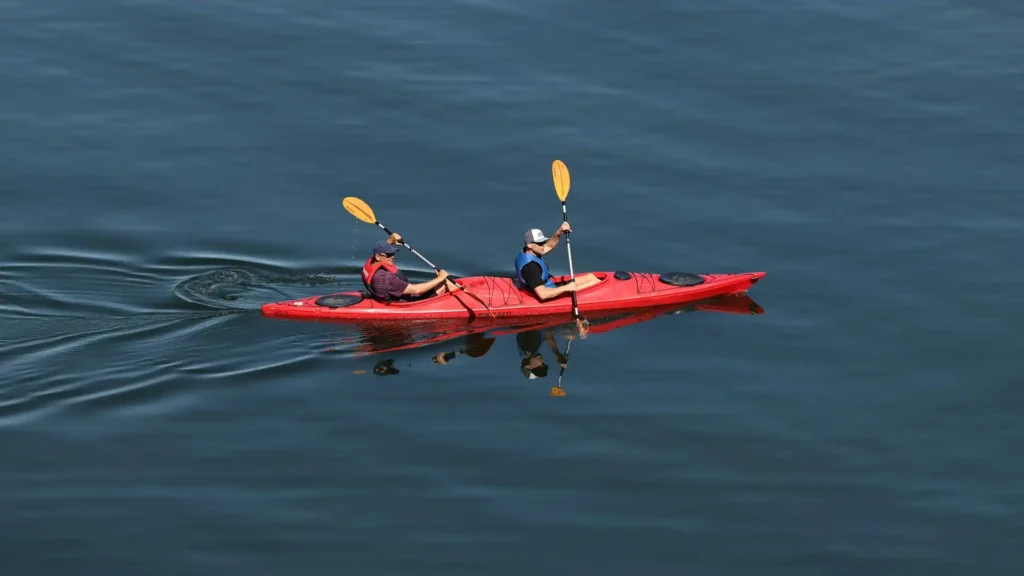Kayaking is an extreme outdoor sports. It gives joy, pleasure and thrill. But the benefits of kayaking don’t end there. It has numerous benefits on your health. Physically, mentally and socially – it supports your overall well-being. Let’s explore.
How Kayaking Does Full-Body Workout
Kayaking activates multiple muscle groups. As you paddle, you have to balance the kayak. To do this, you rely on the upper body, core, and even the lower body. Kayaking can be categorized as both an aerobic and strength-building activity.
Upper Body
Kayaking primarily targets the upper body muscles, especially the arms, shoulders, and back. The repetitive motion of paddling works the deltoids, latissimus dorsi (back muscles), biceps, and triceps.
The upper body’s continuous engagement during kayaking helps tone and strengthen these muscles, offering a great alternative to traditional weightlifting exercises.
Core
In addition to strengthening the upper body, kayaking requires significant core engagement to maintain stability and control. The abdominal muscles, obliques, and lower back work together to stabilize your body and prevent tipping.
Over time, this helps improve posture and enhances core strength. The rotational motion involved in kayaking forces the core to activate with each stroke, leading to better endurance and muscle tone.
Lower Body
When kayaking, the legs are engaged in maintaining balance and occasionally assisting with propulsion, especially when using a tandem or sit-on-top kayak.
Proper leg positioning and pushing off the footrests help maintain a steady rhythm and efficient paddling technique. While the lower body isn’t working as intensely as the upper body, it still plays a vital role in providing stability and power.
Cardiovascular and Endurance Benefits of Kayaking
Kayaking is an excellent form of cardiovascular exercise. The rhythmic, repetitive paddling motion gets your heart pumping. This process improves cardiovascular conditions, and strengthen cardiovascular muscles.
When you kayak at a moderate to vigorous pace, you’re engaging in a low-impact, endurance-building workout that can increase your aerobic capacity and heart health.
Kayaking Helps to Lose Weight
Depending on the intensity and duration of the activity, kayaking can burn a significant number of calories. Recreational kayaking can do this without creating unbearable pressure in your muscles and bones.
On average, an hour of moderate kayaking can burn between 300-400 calories. Whitewater kayaking can burn more calories in less time.
For individuals seeking to lose weight or improve their overall fitness, kayaking provides a great way to do so without the harsh impact on joints associated with running or other high-intensity exercises.
Kayaking Improves Mental Health
Aside from its physical benefits, kayaking also offers profound mental health advantages. When you kayak, you are in nature. Being surrounded by nature and participating in a rhythmic, low-stress activity can bring a lot of mental benefits, like –
- Reduce anxiety
- Improve mood
- Boost cognitive function
Research has shown that outdoor activities can lower stress hormone levels and promote mental clarity.
Kayaking offers a meditative experience that can provide a sense of calm and mental well-being. The rhythmic motions and natural surroundings can help individuals de-stress and clear their minds.
The peaceful nature of kayaking also allows individuals to disconnect from daily stressors, which is particularly beneficial in today’s fast-paced world.
Flexibility and Adaptability
Another reason kayaking is a great workout is its versatility. Whether you’re looking for a leisurely paddle across a calm lake or a challenging expedition through rapids, kayaking can be adjusted to meet your fitness level.
Beginner paddlers can start on flat water, and can grow the muscles for more advanced activities. While experienced kayakers can tackle more challenging environments, such as fast-moving rivers or sea kayaking. It brings mental freshness, and makes muscles flexible.
The ability to modify the intensity of your kayaking session makes it accessible for people of various fitness levels. Kayaking can serve as an excellent introduction to exercise for those new to physical activity or as an advanced workout for seasoned athletes looking to challenge themselves.
The motions involved in paddling require a combination of stretching and reaching that works your arms, shoulders, and spine. The act of rotating your torso while paddling helps to improve spinal mobility and flexibility, which can prevent stiffness and promote better posture.
Additional Benefits of Kayaking
In addition to the physical and mental benefits already discussed, kayaking offers a range of other advantages that contribute to overall health and wellness. Here are some more reasons why kayaking should be considered an excellent workout for you, families and friends:
Improves Balance and Coordination
Kayaking is a game of balance and coordination, especially for beginners. The motion of paddling requires fine motor skills; at first, this seems daunting. But as you gain experience, you naturally develop better coordination between your arms, legs, and core.
Regular practice in kayaking gives you the strength you need for perfect paddling. This is particularly true when navigating through waves or rapids, where your body has to respond quickly to shifting movements in the water.
When you’re out on the water, kayaking requires your body to be in sync with the environment around you. You’re constantly adjusting your balance, which helps improve your coordination and agility.
Enhanced coordination can carry over into other activities, making kayaking an excellent cross-training exercise.
Supports Joint Health
Kayaking is a low-impact exercise. It places less stress on your joints compared to running or weightlifting. The smooth, fluid motion of paddling is gentle on the knees, hips, and lower back, making it a suitable workout for individuals with joint concerns or arthritis. Though kayaking is beneficial for healing joint pain, it can’t heal extreme back pain.
For individuals looking to stay active without risking joint strain, kayaking provides a joint-friendly alternative to more strenuous forms of exercise, offering a full-body workout without causing discomfort or long-term wear and tear on the body.
Boosts Immune Function
Research suggest that regular physical activities improve immune system. Kayaking increases blood circulation and promotes production of certain immune cells. Kayaking helps to lower inflammation.
Spending time outdoors, as is typical with kayaking, can also expose you to sunlight, which helps your body produce vitamin D—an essential nutrient for immune function.
According to a study published by the National Institutes of Health, outdoor exercise, combined with adequate sunlight exposure, can significantly improve the body’s ability to fight off infections and diseases.
Social Interaction and Community Engagement
Kayaking is not only an individual sport but can also be enjoyed in a social setting. Whether you’re kayaking with friends or joining a group for an organized outing, the activity fosters social interaction and a sense of community.
Many people find that kayaking can provide an opportunity to meet like-minded individuals, share experiences, make friends, and bond over a shared love for outdoor activities.
Joining a kayaking club or attending kayaking meetups can help you stay motivated and engaged, which can lead to long-term fitness improvements. Having a supportive community while participating in physical activities enhances your overall experience and can improve your long-term adherence to an active lifestyle.
Environmental Awareness and Eco-Friendly Fitness
Kayaking allows you to explore ecosystems up close. It offers an eco-friendly way to get fit.
For nature enthusiasts, it offers the chance to connect with the environment in a meaningful way. Whether you’re paddling through a serene lake, winding river, or along a coastal shore, kayaking fosters an appreciation for the natural world.
Kayaking is a relatively low-carbon sport.
Additionally, kayaking can help raise awareness about environmental conservation, particularly as the beauty and fragility of aquatic ecosystems.
Kayaking Improves Your Focus
Kayaking is a mentally challenging game, especially when navigating rough waters or unfamiliar environments. As you face obstacles like choppy water or unpredictable currents, kayaking requires focus, quick thinking, and resilience.
These challenges can help build mental toughness and the ability to stay calm under pressure.
The focus required during kayaking helps athletes stay mentally sharp, and overcoming environmental challenges fosters mental resilience. Kayakers often experience a sense of accomplishment and self-confidence after successfully completing a difficult journey.
Conclusion
Kayaking is an incredibly versatile and beneficial workout that provides far-reaching advantages for both physical and mental health. From improving cardiovascular fitness to enhancing balance and flexibility, kayaking strengthens the body in multiple ways while reducing stress and boosting mental clarity. The social benefits, mental resilience, and environmental awareness fostered by kayaking make it more than just a fun outdoor activity—it’s a holistic fitness experience.




